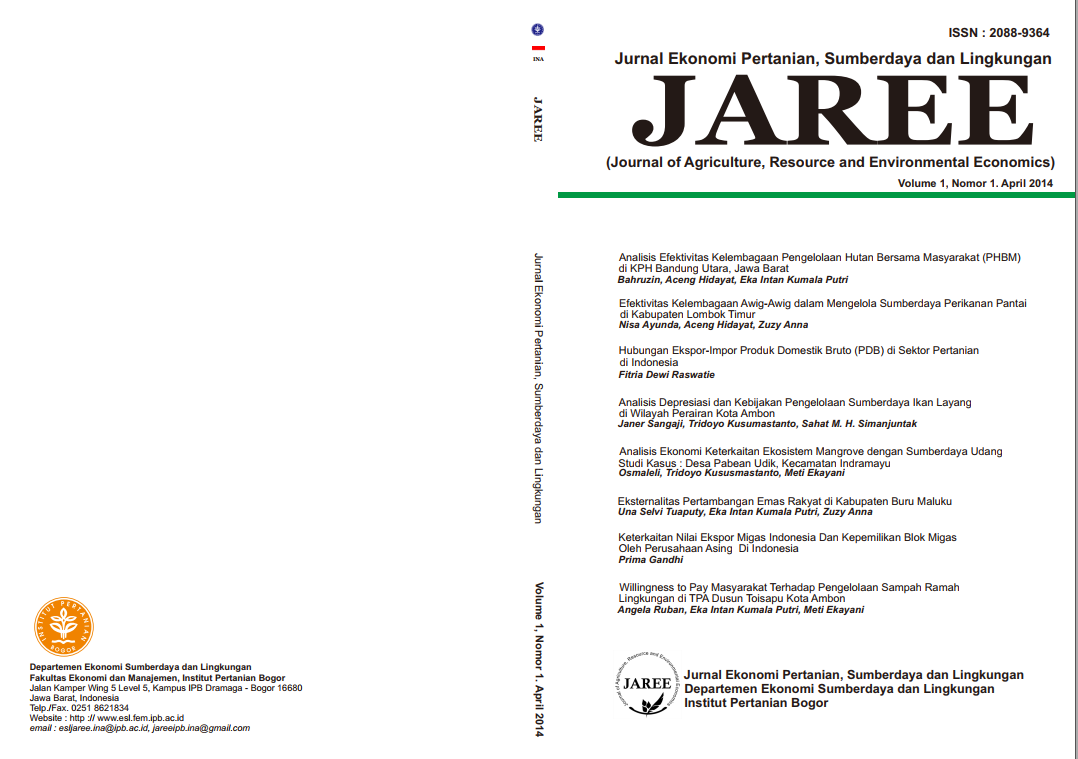Analisis Depresiasi dan Kebijakan Pengelolaan Sumberdaya Ikan Layang di Wilayah Perairan Kota Ambon
Abstract
Generally, fishery resources are open access which means that anyone can participate without having these resources. This is shown by an increase in the utilization of fish resources that will lead to a crisis in which when the rate of exploitation goes beyond the ability of regeneration that makes the catches more economical (economic overfishing). Moreover, this will take place in conditions of uncontrolled fishing. The main factor causing this crisis is the uncontrolled human intervention toward the existing fishery resources. The exploitation of these resources can lead to an imbalance between the input and the potential capture of fish resources so that it can lead to over-fishing, overcapacity, inefficiency arrest, resource rents decline, degradation of the resource stock and a decrease in production. The degradation impact of small pelagic fish resource, especially Layang fish in Ambon also is the reduction of producer welfare, especially the welfare of fishermen and coastal communities. This is due to, among others, the lack of control from the government as the authors,, and the lack of understanding of resource actors (local fishermen) about the nature of fish resources which are open access. Thus, the calculation of the depreciation of small pelagic fish resources, especially lyang fish, and welfare aspects which are considered important to know as a point of reference as well as an early warning signal to determine whether the extraction of small pelagic fish resources, especially layang fish in Ambon has exceeded their capabilities.
Downloads
References
Anderson LG. 2010. Bioeconomics of Fisheries Management. USA: Newark Delaware.
Anna, S. 2003. Model Embedded Dinamik Ekonomi Interaksi Perikanan Pencemaran [disertasi] Bogor (ID). Institut Pertanian Bogor.
Arifin,F. 2008. Optimasi Perikanan Layang di Kabupaten Selayar Provinsi Sulawesi Selatan [tesis]. Bogor (ID): Institut Pertanian Bogor.
Atmajaya,S.B. dan Nugroho, D. 2005. Aplikasi Model Beverton dan Holt bagi Ikan Layang (Decapterus spp) di Laut Natuna dan sekitarnya. [jurnal] Penelitian Perikanan.
[BPS] Badan Pusat Statistik, 2003. Pendapatan Regional Kota Ambon Tahun 2002. Ambon (ID): Badan Pusat Statistik Kota Ambon.
Brandt, A. von. 1984. Fish Catching Methods of The World. 3rd Edition. Warwickshire: Avon Litho Ltd., Stratford-upon-Avon.
Charles A. 2001. Sustainable Fishery Systems. Canada: Blackwell Science Ltd.
[DKP] Dinas Perikanan dan Kelautan Kota Ambon, 2003. Profil Sumber Daya Perikanan dan Kelautan Kota Ambon. Ambon (ID): Dinas Perikanan dan Kelautan Kota Ambon.
Eriyatno. 1999. Ilmu Sistem: Meningkatkan Mutu dan Efektifitas Manajemen. Bogor (ID): IPB Press.
Fauzi, A, 2004. Ekonomi Sumberdaya Alam dan Lingkungan (Teori dan Aplikasi). Jakarta (ID): Gramedia.
______.2005. Kebijakan Perikanan dan Kalautan. Bogor (ID): Grafika Mardiyuana.
______.2010. Ekonomi Perikanan: Teori, Kebijakan dan Pengelolaan. Jakarta (ID): Gramedia.
Fauzi, A dan Anna, S. 2005. Pemodelan Sumberdaya Perikanan dan Kelautan. Jakarta (ID): Gramedia.
Kuncoro, M., 2001. Metode Kuantitatif (Teori dan Aplikasi Untuk Bisnis dan Ekonomi). Yogyakarta (ID): AMP YKPN.
Marimin. 2005. Teknik dan Aplikasi Sistem Pakar Dalam Teknologi Manajerial. Bogor ID): IPB Press.
Marimin. Nurul M. 2010. Aplikasi Teknik Pengambilan Keputusan dalam Manajemen Rantai Pasok. Bogor (ID): IPB-Press.
Muhammadi. et. al. 2001. Analisis Sistem Dinamis: Lingkungan Hidup, Sosial Ekonomi dan Manajemen. Jakarta (ID): UMJ Press.
Nabunome, W. 2007. Model Analisis Bioekonomi dan Pengelolaan Sumberdaya Ikan Demersal di Kota Tegal [tesis]. Semarang (ID): UNDIP.
Nasir, M. 1988. Metode Penelitian. Jakarta (ID): Ghalia Indonesia.
Prihartini, A. 2006. Analisis Tampilan Biologis Ikan Layang Hasil Tangkapan Purse Seine Yang Di Daratkan Di PPN Pekalongan [tesis]. Semarang (ID): UNDIP
Ralahalu, K. A., 2007. Pembangunan Daerah Kepulauan dan Visi Maluku 2030. Pemerintah Provinsi Maluku dan Indonesia Media Otda (IMO), Jakarta.
Sangadji, A., S. 2008. Perikanan/Kelautan Maluku Nasibmu Kini. [internet] [diunduh] [19 Januari 2013]. Tersedia pada: http://www.michr.net.
Saaty TL.1983. Decision Making For Leaders: The Analytical Hierarchy Process For Decision In Complex World. Pittsburgh. RWS Publication.
Sevilla CG, Ochave JA, Punsalan TG, Regala BP, Uriarte GG. 1993. Pengantar Metode Penelitian. Alimuddin Tuwu, penerjemah. Jakarta (ID): UI Press.
Sobari MP, Diniah dan Isnaini. 2009. Kajian Bio-ekonomi dan Investasi Optimal Pemanfaatan Sumberdaya Ikan Ekor Kuning di Perairan Kepulauan Seribu. Jurnal Magrove dan Pesisir.
Sutriono, Hanafie SR. 2007. Filsafat Ilmu dan Metodologi Penelitian. Yogyakarta (ID): CV Andi Offset.
Zulbainarni N. 2012. Pemodelan Bioekonomi dalam Pengelolaan Perikanan Tangkap. IPB Press. Bogor.




